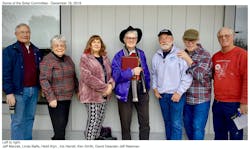Frustrated with Outages, These Seniors Have Big Microgrid Plans, Even Bigger Obstacles
Outage-weary seniors in an Oakmont, California community have encountered numerous regulatory obstacles to their ambitious microgrid plans.
Residents of Oakmont Village Association, whose average age is 75, in 2019 endured five blackouts due to fires and also public safety power shut offs by Pacific Gas & Electric (PG&E), said Ken Smith, chair of the Oakmont Energy Resiliency Project.
The outages — the longest of which was five days — threaten the health and safety of about 20% of the 4,700 residents — people who have mobility challenges and need electricity to operate medical devices, he said.
PG&E provided fossil fuel generators to the community to power some buildings during two but not all of the events, he noted.
The association is eager to implement, as soon as possible, a community microgrid project that would serve buildings in a two-mile area. But because property ownership is not contiguous, the association has encountered numerous snags — chief of which are outdated regulations and lack of precedent, he said.
Seniors moving forward anyway
The association can put solar PV on individual buildings and possibly obtain energy storage systems for each building, but can’t at this time realize its goal of connecting the systems through existing distribution infrastructure. The problem: The association doesn’t have ‘contiguous property’ ownership because privately owned homes are located between the association’s buildings. In California and other states, this limitation — created to protect the local utility’s franchise — hinders private microgrid development.
However, the residents are moving forward, and recently signed a letter of intent with SolarCraft Clean Energy Solutions of Novato, California for solar PV. The group is still working on contract details, and hopes to finalize the deal by the end of January, said Smith.
“The restrictive or obstructive issues are the lack of existing rules, regulations and standards of design for microgrids and micro-utilities and outdated net meter aggregation rules designed for agricultural entities,” he said.
Under “Net Energy Metering-Aggregation” rules, the size of batteries and solar arrays is limited, and it wouldn’t be possible to combine the association’s three electric meters. That significantly reduces the size of the project, said Smith.
For a deep dive into California microgrids, join industry leaders at Microgrid 2020, this year in Philadelpha June 2-3
Proposing resiliency zone
The association proposes converting the association’s central complex and several surrounding buildings into a downtown Oakmont resiliency zone made up of solar, a battery and backup generators.
“The project will include Oakmont Gardens and the commercial buildings in the center of Oakmont that house an ambulance service, grocery store, banks, post office, a church, and some medical offices,” said a summary of the project.
Under the plan, solar panels would be installed on the parking lots of the three community centers, and the solar would power a large energy storage system, according to the project summary. The goal is for the solar plus storage to power the community centers for three days, with fossil fuel generators as backup.
The association has 3,206 homes, a 162-unit senior living facility, Oakmont Gardens (with assisted and independent living), three recreation centers, and a commercial area with a fire station, a market and a dozen other businesses. More than 1,000 residents have mobility and other medical limitations, according to the project summary.
“When a power outage occurs, this group of residents faces an immediate threat, with needs ranging from heating and cooling, interior and exterior light and critical medical devices complicating evacuation,” said the summary.
Long-term microgrid plans city-wide
A long-range plan is to install solar and storage on individual homes in Oakmont. The goal of this plan, separate from the community resiliency project, is to create a city-wide microgrid that can operate independently of the utility power grid.
“This, however, will not occur in the near future,” said the project summary. “The California Public Utility Commission is promulgating rules to govern and incorporate microgrids, but the date for completion of these rules is December 2020, later than the target date for completion of the Oakmont community and residential resiliency programs.”
During the five day outage in October, residents had no heat, lights or internet. When the temperature in Smith’s home dropped to 50 degrees, he left town to stay with a relative.
“It’s a big disruption when for five days you can’t function normally,” Smith said.
The hope is to someday have the option of staying in town, thanks to the proposed solar microgrid. The seniors would like this to happen before the next fire season, but are open to relying on fossil-fueled generators until it’s possible to create a community microgrid.
Track news about microgrid plans and projects in the fast-moving California market. Subscribe to the free Microgrid Knowledge newsletter.








